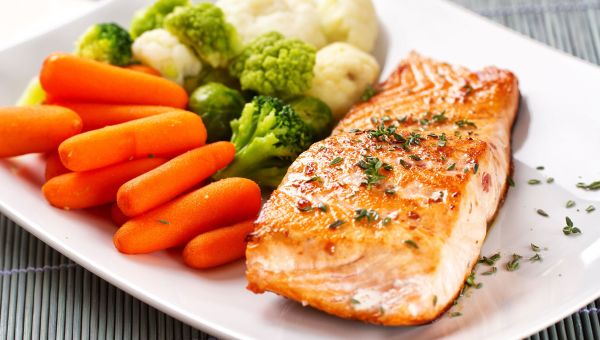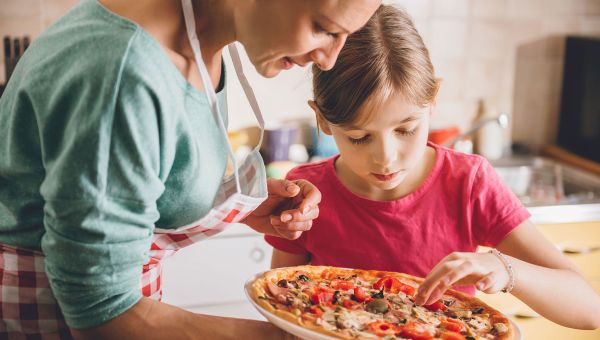6 mealtime mistakes you're probably making
Do you clean your plate, pick the wrong sides and skimp on treats?

Even the most well-meaning parents can contribute to unhealthy childhood weight gain, often without realizing it. One in every five US children between the ages of 6 and 19 are considered obese, defined as having a body mass index (BMI) at or above the 95th percentile. For adults, a BMI of 30 or greater is considered obese. Diet and activity levels influence a child's weight, but his or her home environment can also contribute.
"When Mom and Dad are overweight or obese, there will likely be some unhealthy household factors, like eating and not exercising, watching TV and eating junk food," says Registered Dietitian Lauren Bell with Medical City McKinney in McKinney, Texas.
Childhood obesity has been linked to an increased risk of diabetes, hypertension, high cholesterol, asthma and sleep apnea, so getting your kid's weight under control is important to their long-term health. Bell helps us break down some of the biggest mealtime mistakes families make and offers ways to change bad dietary habits in order to lead a healthier lifestyle—for both kids and adults.

Forcing kids to clean their plates
You may remember being a part of the esteemed "Clean Plate Club" growing up, but pressuring your young ones into polishing off a dish full of food may not be what's best for their waistlines. There are a number of reasons kids load their plates but don't finish their food: they may not like their meal choices or thought they were hungrier than they actually are. In fact, most kids only eat about 60 percent of the food they serve themselves, according to research from Cornell University. Experts suggest it's totally normal.
Pressuring children to clean their plates may encourage eating past the point of fullness, which can become habitual. Offering a sweet reward for children who clean their plates may further increase the number of calories consumed in a single meal. Instead, ask your child to eat until he or she is satisfied, and lead by doing the same. It's a good idea to provide wholesome foods for your child to try, but do it without demanding or raising your voice.

Not preparing enough vegetables
When building a healthy meal, it's best to load half your plate with fruits and vegetables, which are typically low in calories. In fact, US guidelines recommend children between the ages of 2 and 8 consume 1 to 1 ½ cups of vegetables daily. Consumption should increase at age 9 to 2 cups and again at age 14—2 ½ cups for girls and 3 for boys. Young children should get 1 cup of fruit daily. Females should aim for 1 ½ cups by age 14 and males should eat 2 cups per day by the same age. Adults need about the same, but specific portions vary by age, gender and level of activity.
Kids can be picky eaters, and many would rather skip nutrient-rich veggies; nine in every 10 children don't eat enough vegetables, according to the most recent data (collected in 2010) from the Centers for Disease Control and Prevention. Instead of swapping fruits and veggies for higher-calorie or less nutritious foods, Bell recommends making a variety of veggie selections. "Make sure there are always different options, so children aren't stuck at meal time only eating one vegetable," she says.
She also reminds us it can take a child—ages 3 and 4—up to 15 tries to decide whether or not he or she likes a food. Toddlers may need to sample a food five to 10 times, so keep offering up veggies at every meal. Try different preparations and encourage young ones to give them a try.
Another way to encourage healthy eating? Get your kids involved in the kitchen. "Make sure the child feels like they're a part of meal time, that there's something they can always help with and make sure they always have options," Bell says.

Eating meals in front of the television
After a long day of work and school, whipping up a quick meal and plopping in front of the television can be relaxing for parents and entertaining for kids, but it may not be what's healthiest for the whole family. TV is a real distraction, which can take your attention away from the food in front of you and cause you to overeat—without even realizing it. With your mind preoccupied, it's also likely you'll reach the end of your meal without feeling satisfied.
Practicing mindful eating, which includes noticing colors, smells, textures and flavors of your meal, can help prevent unintentional binges and may even promote weight loss. This way of eating may not be intuitive at first, but there are tips to get you started.
- Eat your next meal in silence
- Set a 20-minute timer and use the entirety to eat a normal-sized meal
- Take smaller bites and chew each mouthful well
- Try eating with your non-dominant hand—it'll encourage you to slow things down
Bell also stresses the importance of sitting down for family meals. "If you're eating together, it helps the child see healthy behaviors, and you can see what the child is eating and how much." She adds: "If you're eating together, it's a good time to teach children about each food and how it affects their bodies."

Preparing too many high-calorie options
In the right quantity, most foods can be part of a healthy diet. When the family dinner table is loaded with high-calorie dishes or you stack your plate with large portions, you may see the number on the scale begin to rise.
"Mashed potatoes can be really great for you, but if you eat excessive amounts of it, it's not going to be a good thing," Bell says. "We don't really look at any food as a bad food, it's just how much you eat that can cause weight gain," she adds.
On a day when you’re serving homemade mashed potatoes or pasta—220 and 240 calories per cooked cup, respectively—include several low-calorie dishes. Veggie-based sides, like roasted broccoli, riced cauliflower, zucchini spirals or sauteed mushrooms, are not typically calorie dense, but be mindful of how you're preparing them. A cup of broccoli contains just 31 calories, but the 2 tablespoons of olive oil you drizzled on before roasting add 240. Instead, bake or saute your vegetables in low-sodium broth, with just 14 calories per cup.

Accommodating unhealthy food requests
"Parents' lack of time and energy can lead to picking up fast food or letting kids eat TV dinners, which are normally not a very healthy choice," Bell says. Calling for takeout pizza often has dual benefits: you don't have to cook and your kids don't have to suffer through a plate of veggies. Skipping a home-cooked meal every once in a while won’t send your bathroom scale into a frenzy, but accommodating all of your child's unhealthy meal requests can lead to house-wide weight gain.
A single slice from a 14-inch pizza at a popular restaurant chain contains 295 calories. A small order of chicken nuggets and french fries contains 400 calories and 21 grams of fat. The same serving of fries and a cheeseburger has a bit more—520 calories and 23 grams of fat.
When baked chicken breast and roasted veggies aren't a palatable option, whip up some of your takeout favorites at home. Top a small pita with no-sugar-added tomato sauce, a light sprinkle of mozzarella cheese and fresh vegetables for a guiltless Italian dinner. Or cube skinless chicken breast, coat with breadcrumbs and bake. Pair your (healthier) chicken nuggets with homemade baked fries, which save on excess oil and calories.

Depriving kids of the occasional treat
If a parent or guardian notices a child gaining weight or the young one is already overweight, restricting sweets and junk food may seem like the responsible thing to do. Unfortunately, it may not have the intended effect. "Children of parents who control their food too much can be kind of rebellious," Bell says. "They might experiment with a bunch of junk food outside of the household."
Restricting a child's intake of certain foods, especially eats they find particularly tasty, can actually increase their desire and consumption, according to a small study published in 2014. The research, which included 37 children, found that overly controlling mealtime practices can produce a negative outcome, especially among children with "lower inhibitory control," or a lesser ability to appropriately control his or her temperament.
Instead, make treats part of a healthy diet—in moderation. Offer your young one a sweet or salty snack on occasion and set a standout example by nourishing your own body with nutritious foods.
This content originally appeared on Sharecare.com.
More On


video

article

slideshow


video


video
